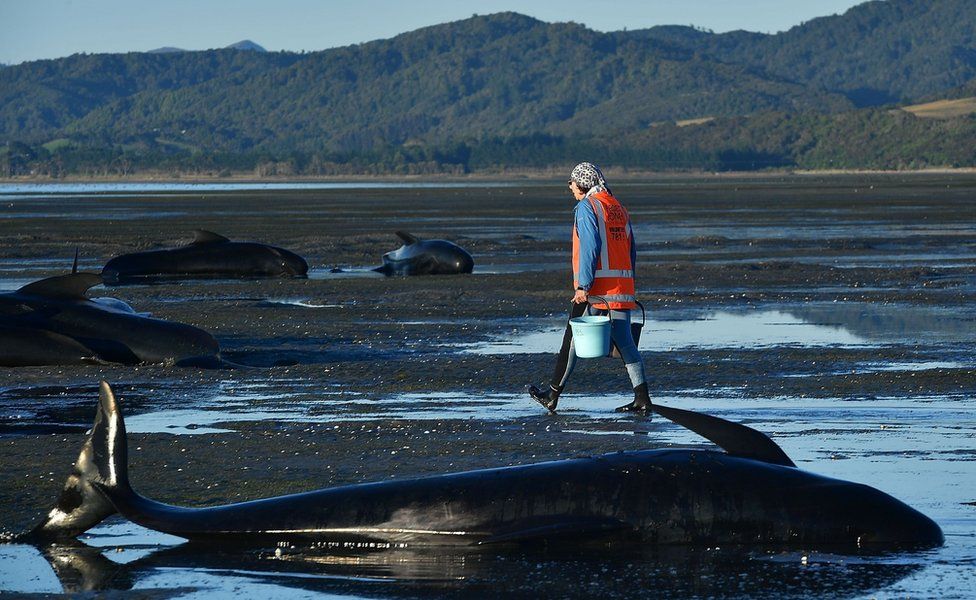What makes this New Zealand beach a whale graveyard?
- Published

Each year locals from Golden Bay at the top of New Zealand's South Island know to expect a whale beaching at a narrow strip of sand curving into the Cook Strait, known as Farewell Spit. Ben Collins looks at what makes the area so deadly.
Each year, according to the conservation group Project Jonah, around 300 dolphins and whales become stranded in New Zealand.
Many of these incidents occur at Farewell Spit, a thin arc of sand at the top of the South Island which separates a shallow bay from the open ocean.
Last week, more than 400 pilot whales became stranded on this 5km-long (three mile-long) stretch and, while some were saved by conservation officials and volunteers in a desperate rescue effort, most died.
The beachings occur in the summer months, according to Gary Riordan, who is 62 and has lived in the area for most of his life.
"It pretty much happens every year," says Mr Riordan, who runs a beachside camp ground not far from where they often become stranded.
"There's a lot of theories out there as to why it happens, but at the end of the day I think there's four or five hotspots where they strand [in New Zealand], and the one thing they all have in common is shallow water."
"As far as often goes: It's pretty much seasonal, always around January or February. It's something that the locals expect every year about this time."
Joanna Wheaton, who also lives in the area, said she was pleasantly surprised there wasn't a mass stranding in 2016.
"Farewell Spit is a unique natural trap for them," she says.
In February 2015 about 200 pilot whales - which, despite their name, are actually members of the dolphin family - beached not far from the cafe where she works. At least half of them died.
"It's always the same species, pilot whales, and the same extreme tide situation on the inner beach," she says.
Dr Rochelle Constantine, a marine biologist at the University of Auckland, also says the shallow water around Farewell Spit is what causes the whales to beach.
"Farewell Spit, geographically, is quite an interesting place," she says. "It spans around in a broad arc. On either side is large bay and the open ocean.
"There's a series of really large sand banks all through there in the bay, and it just gradually becomes more and more shallow," Dr Constantine says.
Because the water becomes shallower gradually, the whales may not be able to detect the change using echo-location, in the same way they would a sudden rise in gradient, she says.
"They can echo-locate, but it's [a problem with] the signal that they get bounced back. It's a combination of this gentle gradient and the soft sand. They probably aren't detecting that they are swimming into more and more shallow water."
By the time they do realise, it's often too late. The tide has already begun to run out.
Farewell Spit is especially deadly as it sits, like a hook, right in the pilot whales' path.
"They can swim straight into Golden Bay and the embrace of the Farewell Spit. It's just geographically a very tricky spot," Dr Constantine says.
While the shallow water and its effect on echolocation is the most likely reason the animals become stranded at Farewell Spit, Dr Constantine says pilot whales also have strong social bonds, and this could explain why such large numbers become stuck, or return once rescuers re-float them.
"I have attended a fair few strandings and what is highlighted is how variable they all are," she says.
"We do know that because they are quite strongly socially-bonded, they will hang out with each other, but to be honest, every stranding is different. Sometimes they just muck up and don't get the right cues, and other times its because they are strongly bonded to [stranded] individuals in the group."
"We think there's some confusion going on in each stranding, but finding a reason is often difficult," she says.
Scientists don't know for sure why they regularly beach in January or February, though Dr Constantine said it could be because of feeding patterns and changes in ocean temperature which see more whales passing through the Cook Strait at that time of year.
"These are quite hard things to measure as scientists, because the reality is we don't often see pilot whales in this area until they are about to strand. They are not really coastal."
"We really don't know much about the movements of pilot whales in New Zealand. It could be simply they are not around at other times of the year."
According to the New Zealand Department of Conservation, the largest recorded stranding was an estimated 1,000 pilot whales on the Chatham Islands, another stranding hotspot, in 1918.
- Published13 February 2017
- Published12 February 2017
- Published11 February 2017
- Published8 February 2017
- Published9 December 2016
- Published26 January 2016
- Published7 October 2016
- Published14 February 2015